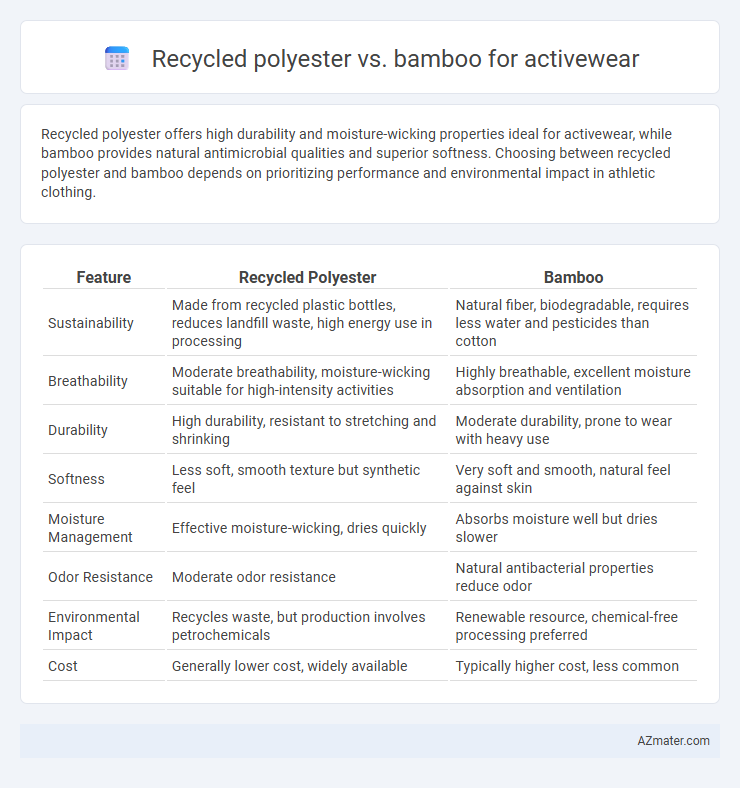Recycled polyester offers high durability and moisture-wicking properties ideal for activewear, while bamboo provides natural antimicrobial qualities and superior softness. Choosing between recycled polyester and bamboo depends on prioritizing performance and environmental impact in athletic clothing.
Table of Comparison
| Feature | Recycled Polyester | Bamboo |
|---|---|---|
| Sustainability | Made from recycled plastic bottles, reduces landfill waste, high energy use in processing | Natural fiber, biodegradable, requires less water and pesticides than cotton |
| Breathability | Moderate breathability, moisture-wicking suitable for high-intensity activities | Highly breathable, excellent moisture absorption and ventilation |
| Durability | High durability, resistant to stretching and shrinking | Moderate durability, prone to wear with heavy use |
| Softness | Less soft, smooth texture but synthetic feel | Very soft and smooth, natural feel against skin |
| Moisture Management | Effective moisture-wicking, dries quickly | Absorbs moisture well but dries slower |
| Odor Resistance | Moderate odor resistance | Natural antibacterial properties reduce odor |
| Environmental Impact | Recycles waste, but production involves petrochemicals | Renewable resource, chemical-free processing preferred |
| Cost | Generally lower cost, widely available | Typically higher cost, less common |
Introduction to Sustainable Activewear Fabrics
Recycled polyester and bamboo are leading sustainable fabrics transforming activewear by reducing environmental impact. Recycled polyester, made from post-consumer plastic bottles, offers durability and moisture-wicking properties ideal for high-performance sportswear. Bamboo fabric provides natural breathability, antibacterial benefits, and biodegradability, making it a popular eco-friendly choice for lightweight, comfortable activewear.
What is Recycled Polyester?
Recycled polyester is a sustainable fabric made from repurposed plastic waste, such as PET bottles, reducing landfill waste and lowering carbon emissions compared to virgin polyester production. Its moisture-wicking properties and durability make it ideal for activewear, offering performance benefits while supporting eco-friendly fashion. This material aligns with circular economy goals, promoting resource efficiency and reduced environmental impact in textile manufacturing.
Understanding Bamboo Fabric
Bamboo fabric, derived from bamboo pulp, offers natural moisture-wicking and antibacterial properties ideal for activewear, promoting breathability and odor resistance. Compared to recycled polyester, bamboo fabric is biodegradable and more sustainable due to its renewable source and low-impact processing. Understanding bamboo's eco-friendly benefits and performance qualities helps in selecting a fabric that balances comfort, functionality, and environmental responsibility for activewear applications.
Environmental Impact: Recycled Polyester vs Bamboo
Recycled polyester significantly reduces plastic waste by repurposing PET bottles and other plastic materials, lowering landfill accumulation and decreasing reliance on virgin petroleum resources. Bamboo, a fast-growing, renewable plant, offers a biodegradable alternative with natural antimicrobial properties but often requires intensive chemical processing to convert fibers for activewear use, potentially impacting water quality. Choosing between recycled polyester and bamboo involves balancing recycled content benefits against bamboo's sustainability credentials and processing environmental footprint.
Comfort and Performance in Activewear
Recycled polyester offers excellent moisture-wicking and durability, making it ideal for high-performance activewear that requires long-lasting comfort and resistance to wear. Bamboo fabric provides superior breathability and natural antibacterial properties, enhancing odor control and softness against the skin for a more comfortable workout experience. Both materials contribute to sustainable activewear, but the choice depends on prioritizing performance longevity with recycled polyester or enhanced comfort and eco-friendliness with bamboo.
Breathability and Moisture-Wicking Comparison
Recycled polyester excels in moisture-wicking capabilities by efficiently drawing sweat away from the skin, making it ideal for high-intensity activewear that requires rapid drying. Bamboo fabric offers superior breathability due to its natural micro-gaps that enhance air circulation, providing a cooler feel during moderate activity. While recycled polyester supports durability and quick moisture management, bamboo excels in comfort and odor control, making each suitable for different activewear needs.
Durability and Longevity Factors
Recycled polyester offers superior durability and moisture-wicking properties, making it ideal for activewear that endures frequent washing and intense physical activity. Bamboo fibers provide natural breathability and softness but tend to degrade faster under repeated stress and high abrasion. Choosing recycled polyester ensures longer-lasting performance and resistance to wear, while bamboo emphasizes comfort over extended durability.
Production Process and Resource Use
Recycled polyester is produced by melting down plastic waste, such as PET bottles, reducing reliance on virgin petroleum and lowering carbon emissions compared to virgin polyester production. Bamboo fabric involves harvesting fast-growing bamboo plants, which require minimal pesticides and water, but converting bamboo into soft textiles often relies on chemical processing that can impact environmental sustainability. Both materials offer eco-friendly advantages, but recycled polyester emphasizes waste reduction while bamboo depends on renewable growth with some chemical-intensive processing steps.
Cost and Accessibility Analysis
Recycled polyester offers competitive pricing due to its established supply chain and widespread availability, making it a cost-effective choice for activewear brands focused on sustainability. Bamboo fabric, while praised for its natural antibacterial properties and softness, tends to be pricier and less accessible due to limited large-scale processing facilities and higher raw material costs. Brands aiming for budget-friendly activewear production often favor recycled polyester, whereas bamboo appeals to niche markets willing to invest in eco-conscious luxury options.
Which Fabric is Best for Activewear?
Recycled polyester excels in activewear due to its moisture-wicking properties, durability, and resistance to stretching and shrinking, making it ideal for high-performance activities. Bamboo fabric offers natural breathability, antibacterial qualities, and softness, providing comfort and odor control, but it may lack the same level of moisture management under intense workouts. Choosing the best fabric depends on activity intensity and sustainability priorities, with recycled polyester favored for rigorous exercise and bamboo preferred for lighter, eco-conscious wear.

Infographic: Recycled polyester vs Bamboo for Activewear
 azmater.com
azmater.com